Room temperature soap making (70-80°F) creates superior bars by preventing temperature shock and preserving delicate essential oils and fragrances. You'll achieve better emulsification as consistent temperatures allow oils and lye to blend more thoroughly, creating denser bars with smoother textures and enhanced lather. The slower crystal formation process yields bars with better moisturizing properties and prevents cloudiness or sediment. Discover how proper equipment and technique can transform your homemade soap from ordinary to extraordinary.
The Science Behind Room Temperature Soap Making
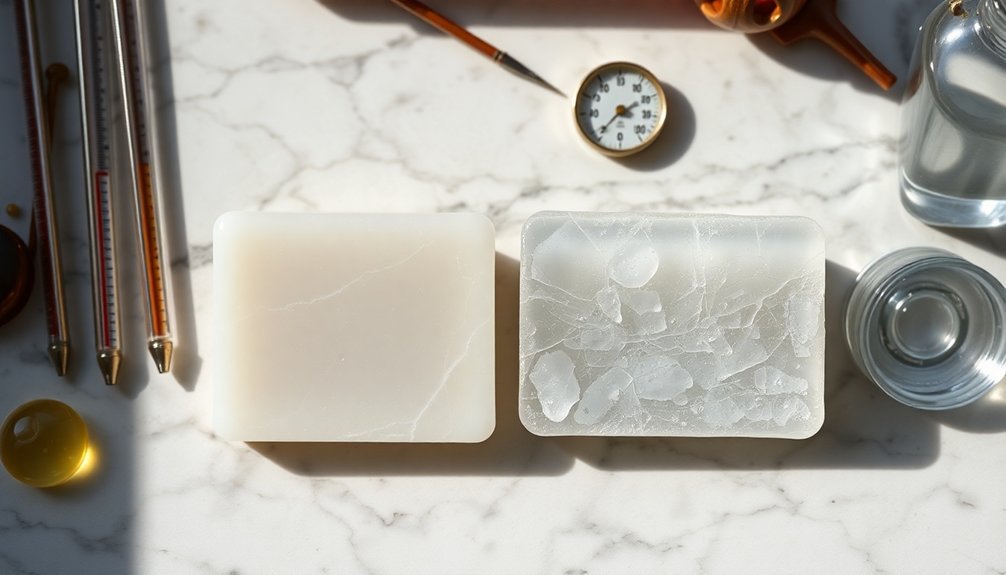
While many soap makers believe high temperatures are necessary for the saponification process, room temperature soap making actually offers significant advantages.
When you work at temperatures between 70°F and 80°F, you'll achieve better emulsification of oils and lye, resulting in a more uniform mixture.
Room temperature conditions prevent cold lye solutions from solidifying your oils prematurely, which would otherwise compromise the saponification process. Your oils maintain ideal trace consistency, essential for achieving desired textures and designs in your finished bars.
Perhaps most importantly, consistent room temperature helps you avoid temperature shock, which can cause separation or incomplete saponification. This steady environment facilitates the chemical reactions necessary for creating high-quality soap.
The result? You'll produce bars with superior lather and enhanced moisturizing properties that outperform their high-temperature counterparts.
Benefits of Low-Heat Saponification
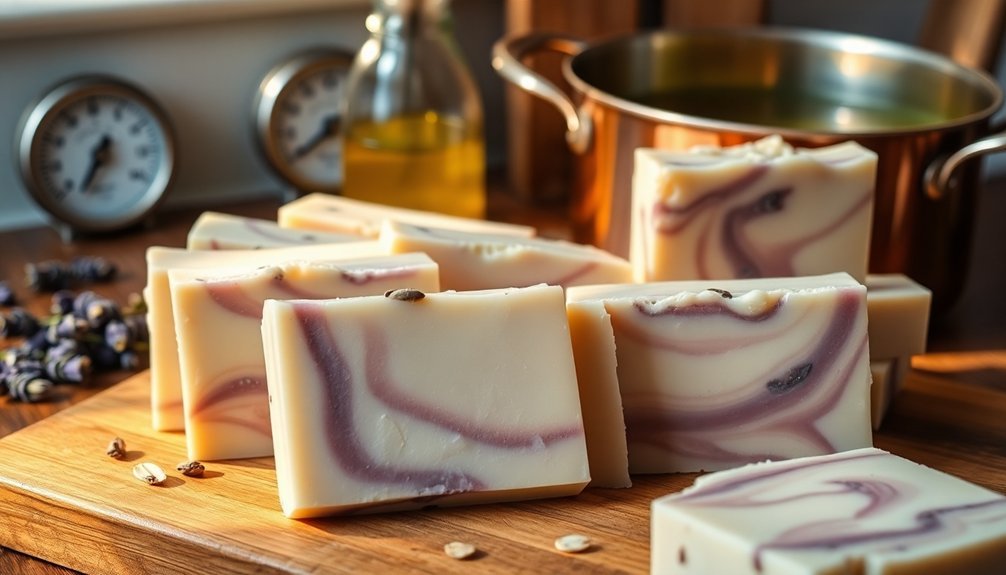
Low-heat saponification works wonders for preserving delicate ingredients like essential oils and herbal infusions in your homemade bars.
You'll find that keeping temperatures below 120°F allows these sensitive components to maintain their therapeutic properties and natural fragrances rather than evaporating or breaking down.
The cooler process also encourages slower crystal formation, creating a denser, more luxurious bar with superior lather and longer-lasting qualities.
Preserves Delicate Ingredients
When crafting homemade bars, the gentle process of low-heat saponification offers remarkable benefits for preserving delicate ingredients.
By keeping temperatures below 140°F, you'll maintain the integrity of essential oils, vitamins, and natural flavors that make your bars special. Room temperature ingredients create a consistent mixture that emulsifies properly, preventing the uneven saponification that can ruin your final product.
Three key advantages of this approach:
- Protection of sensitive compounds – Delicate ingredients remain intact, delivering their full benefits in your finished bars.
- Enhanced texture – Better emulsification at moderate temperatures creates smoothly textured bars with superior mouthfeel.
- Superior quality – The preserved flavors and nutrients contribute to a more vibrant, premium product that stands out from commercial alternatives.
Slower Crystal Formation
The gentle pace of room temperature saponification creates a perfect environment for slower crystal formation in your homemade bars.
When you allow soap to develop at room temperature, you'll notice finer crystals forming throughout the mixture, resulting in a considerably smoother texture in your finished product.
This controlled formation prevents the unsightly separation and uneven texture that often occurs with high-heat methods.
Your oils and lye emulsify more thoroughly, creating a homogenous mixture that enhances your soap's durability.
You'll also appreciate how this gradual process preserves essential oils and fragrances better, giving you more fragrant soap bars.
Essential Oils Preservation in Room Temperature Methods

Although essential oils are known for their potent aromatic properties, they require proper preservation techniques to maintain their efficacy in homemade bars. When you work with room temperature ingredients, you're creating ideal conditions for your essential oils to retain their quality and therapeutic benefits.
Proper temperature management enhances your homemade bars in several ways:
- Keeping oils at 68°F-72°F prevents evaporation and preserves their fragrance and medicinal properties.
- Room temperature storage minimizes oxidation that would otherwise degrade your oils' quality over time.
- Consistent temperature ensures better distribution of essential oils throughout your bars, resulting in more uniform scent and benefits.
You'll avoid cloudiness and sediment formation by maintaining steady storage temperatures, which ultimately yields professionally crafted homemade bars with maximum aromatic impact and therapeutic value.
Equipment Needed for Room Temperature Soap Making
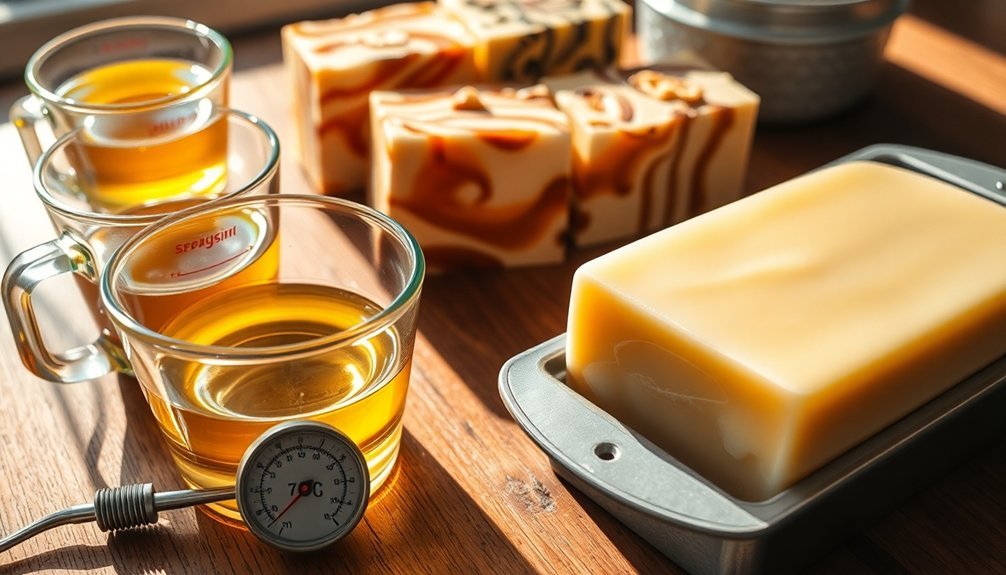
Now that you've mastered preserving essential oils in your homemade bars, let's focus on gathering the right tools for room temperature soap making.
A digital scale is non-negotiable—you'll need precise measurements to guarantee proper saponification occurs between your oils and lye solution.
Invest in a quality stick blender to achieve trace quickly without overheating your mixture. A reliable thermometer helps you maintain consistent room temperature throughout the process, preventing texture issues in your final product.
Don't overlook high-quality soap molds—silicone or wooden options will release your bars easily once set.
Finally, never skip safety gear; proper gloves and goggles protect you from potential lye burns while handling ingredients.
With these essential tools at hand, you're fully equipped to create perfectly balanced soap bars at room temperature.
Selecting Oils for Optimal Room Temperature Results
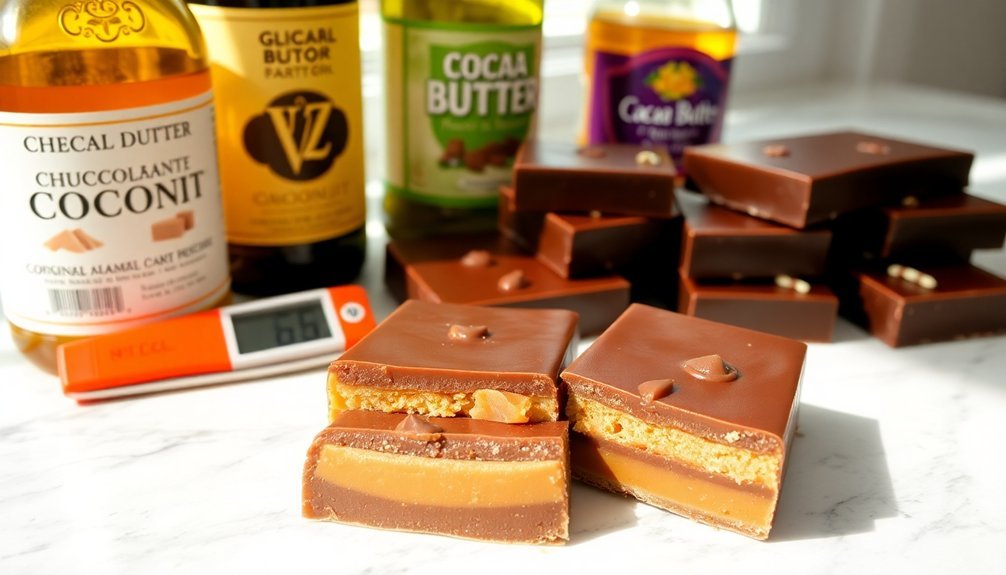
You'll need to select oils with appropriate melting points for your homemade bars to achieve the best texture at room temperature.
When oils are properly matched to your recipe temperature, they'll emulsify more effectively with other ingredients, preventing unwanted separation that can ruin your bars.
Choosing room temperature oils like canola or coconut oil helps guarantee a smooth, cohesive mixture that maintains structural integrity as your bars set.
Oil Melting Points Matter
Understanding the melting points of different oils is essential when crafting homemade bars that need to maintain their integrity at room temperature. Oils like canola and olive remain liquid at room temperature, creating better consistency in your homemade bars by promoting proper emulsification with other ingredients.
When selecting oils, consider these texture-affecting factors:
- Lower melting point oils (canola, olive) blend more easily with room temperature ingredients, ensuring even moisture distribution.
- Coconut oil solidifies below 76°F, potentially creating denser, less cohesive mixtures if not properly warmed.
- Higher melting point oils like palm can make bars too firm when cooled, compromising the desired texture.
Choose oils strategically based on their melting points to control your bars' final texture and achieve that perfect balance between moisture and structure.
Preventing Texture Separation
When homemade bars develop an unappetizing separated texture, the culprit is often improper oil selection. Choose oils that remain liquid at room temperature, like canola or sunflower oil, to guarantee consistent emulsification throughout your mixture.
These oils help prevent texture separation while facilitating better blending with other ingredients.
Avoid using coconut oil without properly warming it to 68-72°F first, as it solidifies at cooler temperatures and creates clumpy textures.
Remember that room temperature ingredients bond more effectively, enhancing the consistency of the batter. Oils with higher smoke points also maintain their structure during baking, contributing to a more uniform final product.
For perfect homemade bars, confirm all components—especially oils—are at identical temperatures before mixing.
This simple step dramatically improves texture cohesion and prevents that dreaded separated appearance.
Lye Solution Management Without Heat
Although working with lye requires careful handling, managing your lye solution without heat considerably reduces safety risks while improving your final product.
When you mix lye at room temperature, you'll create a more stable pH environment that supports ideal saponification while avoiding dangerous rapid reactions that can occur with heated solutions.
For consistently excellent homemade bars:
- Always use room temperature water when dissolving your lye, which guarantees even distribution without the complications of heat-induced reactions.
- Prepare your solution in a well-ventilated area to prevent steam buildup that could create pressure hazards.
- Allow your lye solution to fully dissolve and stabilize before incorporating it into your oils for better consistency in your final bars.
This approach creates smoother textures and more uniform results in your finished products.
Achieving Trace Without Thermal Acceleration
Achieving proper trace in your cold-process bars depends greatly on the stable emulsion formed when ingredients blend at room temperature.
You'll notice that warmer oils and butters combine more effectively with your lye solution, allowing the saponification process to progress naturally without heat assistance.
This temperature equilibrium creates ideal conditions for the mixture to thicken predictably, revealing that characteristic "trace" when your spatula leaves a lasting imprint on the surface.
Emulsion Stability Factors
The foundation of stable homemade bars rests on proper emulsification at room temperature, where ingredients blend seamlessly without requiring heat acceleration.
When you're combining fats and liquids, temperature uniformity becomes your strongest ally in creating that perfect stable mixture.
Using room temperature ingredients offers three critical advantages:
- Even mixing – Components at similar temperatures bind more effectively, preventing separation and ensuring consistent texture throughout your homemade bars.
- Air incorporation – Proper emulsification traps tiny air bubbles, creating lighter, fluffier results that improve mouthfeel.
- Preventing breakage – Cold ingredients can cause emulsions to break, resulting in clumpy mixtures that compromise your bars' integrity.
The careful monitoring of ingredient temperatures eliminates the risk of unstable emulsions, guaranteeing your homemade bars achieve that professional-quality texture you're aiming for.
Temperature Affects Saponification
While many soapmakers rush the process with heat, proper saponification actually thrives at room temperature.
You'll achieve better control and consistency when you allow lye and fats to react naturally without thermal acceleration. This measured approach prevents premature thickening, giving you more time to work with your mixture.
Cold oils can sabotage your soap batch by causing uneven reactions and lumpy results. Instead, maintain a consistent room temperature during mixing to guarantee ingredients become fully emulsified. This creates a smoother final product with uniform texture throughout.
The slower saponification process at room temperature also offers practical advantages when adding fragrances or colorants. Without excessive heat driving the reaction, you'll reach trace at the perfect pace—when your mixture holds shape when drizzled—allowing for creative additions without risking separation.
Coloring Techniques for Room Temperature Soap
Because room temperature soap provides ideal conditions for colorant dispersion, you'll find it's the perfect canvas for creative expression.
Working with soap at stable consistency allows you to incorporate colorants evenly without disrupting saponification. You'll achieve vibrant, uniform hues as the neutral temperature prevents overheating that could alter your colorants' properties.
When coloring your room temperature soap, consider these proven techniques:
- Use liquid colorants for precision – they blend seamlessly without clumping and give you exact control over your final shade.
- Add mineral-based colorants like micas and oxides directly to room temperature batches to preserve their vibrant properties.
- Take advantage of better dispersion by incorporating colors gradually, ensuring even distribution throughout your soap bar.
Fragrance Retention in Cold Process Methods
Since volatile compounds easily escape in warmer environments, cold process methods dramatically improve fragrance retention in your homemade bars. The lower temperatures inhibit chemical reactions that would otherwise degrade your carefully selected scents, preserving their integrity throughout the creation process.
| Fragrance Factor | Cold Process | Room Temperature |
|---|---|---|
| Volatile Compounds | Preserved | Dissipate quickly |
| Essential Oils | Maintain integrity | Degrade |
| Chocolate/Spice Notes | Enhanced | Subdued |
| Scent Longevity | Extended | Shortened |
| Sensory Experience | Rich, complex | Flatter profile |
When you use cold process methods, you'll notice your bars deliver a more concentrated flavor retention. The sensory experience becomes richer as fragrance compounds remain intact rather than evaporating. Your homemade bars will showcase deeper aromatic complexity with none of the flat notes typical of room temperature processing.
Mold Selection for Room Temperature Curing
Beyond fragrance preservation, your selection of molds fundamentally shapes the outcome of room temperature curing processes.
When choosing your ideal mold, consider how different materials interact with your homemade bars. Silicone molds offer easy release without sticking, while metal options conduct heat more efficiently for even curing throughout.
For best results with room temperature methods:
- Choose shallow molds to reduce curing time by increasing surface area exposure to air.
- Select molds with non-stick coating to simplify removal and preserve the bar's smooth finish.
- Match your mold size to your intended batch size to maintain proper thickness, which directly impacts texture and flavor.
Remember that glass molds provide stable, consistent heat retention, while proper mold selection guarantees your bars develop their intended characteristics regardless of environment.
Troubleshooting Common Room Temperature Soap Issues
While room temperature soap making offers simplicity, it's not without challenges that can perplex even experienced crafters.
If you're noticing clumpy mixtures or uneven texture in your soap, check whether your ingredients have truly reached room temperature. Cold oils and butters won't incorporate properly with lye.
When your soap reaches trace too quickly, it's often because your ingredients weren't adequately warmed. Room temperature fats guarantee a more manageable trace time and proper emulsification.
Remember that consistent temperatures throughout the process prevent separation and create stable bars.
Don't overlook your additives. Essential oils should be at room temperature before adding to maximize their scent throw.
Time Considerations for Room Temperature Saponification
Although many soapmakers rush the process, room temperature saponification requires patience to achieve ideal results.
When you maintain your ingredients at 68°F-72°F, you'll create a consistent mixture that reacts properly, yielding higher quality bars. Cold ingredients slow the chemical reaction, often leading to incomplete saponification and compromised quality.
For best results with room temperature soapmaking:
- Allow 24-48 hours for the saponification process to complete fully.
- Monitor ambient temperature throughout curing to guarantee it remains at room temperature.
- Resist the urge to accelerate the process, as patience directly impacts the final consistency.
Remember that the time investment pays off in superior bars. The proper chemical reaction can't be rushed if you want that perfect balance of hardness and quality in your homemade soap.
Frequently Asked Questions
Why Is It Important to Use Room Temperature Ingredients in Making Butter Cake?
You'll need room temperature ingredients for butter cake because they mix better, creating air pockets during creaming. Your butter should be about 65°F to guarantee proper emulsification, leading to a fluffier, evenly-baked cake.
Why Is It Important for Butter to Be Room Temperature?
Room temperature butter creates the ideal consistency for creaming with sugar. You'll trap more air, achieve better emulsification with other ingredients, and guarantee even fat distribution—resulting in lighter, fluffier baked goods with superior texture.
What Happens if Ingredients Are Not at Room Temperature?
Cold ingredients won't emulsify properly, creating a clumpy batter. You'll end up with uneven textures, curdled mixtures, and denser bars. Your butter won't cream well with sugar, reducing airiness in the final product.
What Happens if You Don't Use Room Temperature Butter?
If you don't use room temperature butter, your bars will turn out dense and clumpy. You'll struggle with proper mixing, creating an uneven texture with poor fat distribution and possibly a greasy, sunken appearance.
In Summary
You'll find that room temperature soap making gives you superior bars with richer scents and more vibrant colors. While it requires patience as the saponification process takes longer, your reward is a gentler soap that preserves essential oil properties. By mastering this method, you're creating artisanal bars with better texture and skin-loving qualities that simply can't be matched by hot process techniques.

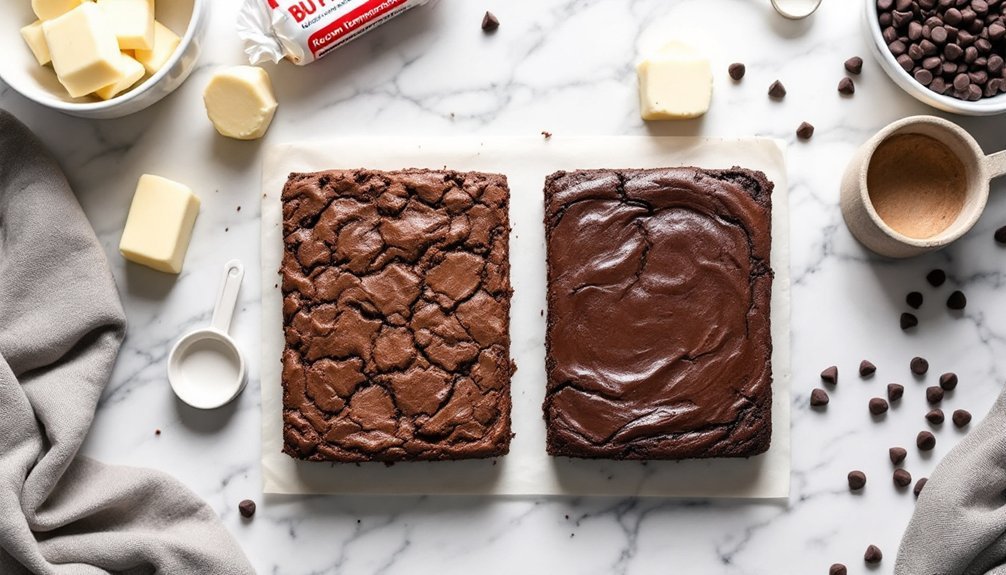



Leave a Reply